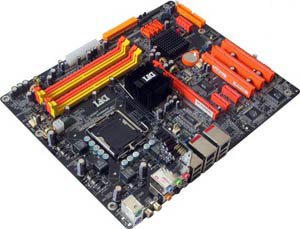A Trio of Thermaltake Towers
by Joshua Buss on August 16, 2006 2:30 AM EST- Posted in
- Cases/Cooling/PSUs
Benchmark Comparisons
To get as meaningful a comparison as possible between the three cases we installed the same set of hardware into each one: our standard ATX test bed. Each system used the default fan configuration the case came with, which meant two 120mm fans running at 12V in each case. The ambient air temperature during all tests was kept at a steady 23.5 degrees Celsius.
With similar overall designs and the same number and placement of fans in each case, we didn't expect to see much difference in cooling performance between the three units. However, taking a look at the component temperatures chart below showed us that we needed to look a little closer at what each case was doing thermally.

No doubt the reason the Eureka was getting such low CPU and GPU temperatures was its large ventilated area on the side panel directly above these components. This decision is interesting for a case designed more for sever use though, considering it sacrifices airflow over the hard drives, which shows up as considerably higher temperatures for our system hard drive and MOSFETs.
Between the Eclipse and the Aguila, things are much closer. Without ventilation on the sides they pull the majority of the air through the front, resulting in much lower hard drive temperatures - especially under load. Both cases keep generally good temperatures across the board, but the Aguila's ability to stifle drastic heat changes from idle to load certainly deserves merit.
The temperature benchmarking results are interesting at the most, but the noise level testing was downright shocking for the three cases.

Even with only two large fans, the Eureka case came in registering a full 42 dB-A on our sound meter. This surprised us, because subjectively, we really felt the Eclipse was just as noisy. It seemed that the rear fan in both cases could benefit form a fan controller reducing its voltage to 10 or 9 volts - at the stock 12 V setting there was a very noticeable hum from the Eclipse and the sound of moving air from the Eureka.
Coming out of this arena the Aguila was a clear champion. With competitive temperatures and a very pleasant lack of annoying whines, the Aguila's fans were definitely tuned and placed the best for good performance without annoying sound levels.
To get as meaningful a comparison as possible between the three cases we installed the same set of hardware into each one: our standard ATX test bed. Each system used the default fan configuration the case came with, which meant two 120mm fans running at 12V in each case. The ambient air temperature during all tests was kept at a steady 23.5 degrees Celsius.
| ATX Test Bed | |
| DFI LanParty UT 915P-T12 Pentium 4 530 Prescott 3.0ghz OCZ 512MB DDR2 x 2 Zalman CNPS 9500 Heatsink Seagate 120gb SATA Hard Drive Chaintech GeForce 6600GT Zalman VF-700 Cu GPU Cooler MSI DVD-CD/R/RW Combo drive Zalman ZM460-APS PSU |
 |
With similar overall designs and the same number and placement of fans in each case, we didn't expect to see much difference in cooling performance between the three units. However, taking a look at the component temperatures chart below showed us that we needed to look a little closer at what each case was doing thermally.

No doubt the reason the Eureka was getting such low CPU and GPU temperatures was its large ventilated area on the side panel directly above these components. This decision is interesting for a case designed more for sever use though, considering it sacrifices airflow over the hard drives, which shows up as considerably higher temperatures for our system hard drive and MOSFETs.
Between the Eclipse and the Aguila, things are much closer. Without ventilation on the sides they pull the majority of the air through the front, resulting in much lower hard drive temperatures - especially under load. Both cases keep generally good temperatures across the board, but the Aguila's ability to stifle drastic heat changes from idle to load certainly deserves merit.
The temperature benchmarking results are interesting at the most, but the noise level testing was downright shocking for the three cases.

Even with only two large fans, the Eureka case came in registering a full 42 dB-A on our sound meter. This surprised us, because subjectively, we really felt the Eclipse was just as noisy. It seemed that the rear fan in both cases could benefit form a fan controller reducing its voltage to 10 or 9 volts - at the stock 12 V setting there was a very noticeable hum from the Eclipse and the sound of moving air from the Eureka.
Coming out of this arena the Aguila was a clear champion. With competitive temperatures and a very pleasant lack of annoying whines, the Aguila's fans were definitely tuned and placed the best for good performance without annoying sound levels.










43 Comments
View All Comments
mostlyprudent - Wednesday, August 16, 2006 - link
I have been wrestling over the case issue recently. I like the looks of the Antec P150, but need door to keep the kids from turning off the PC at random. I like the P180, but it's too big. I've considered the Sonata II, but want a different PSU. Any idea how the Aguila compares performance-wise to the Antec cases?KorruptioN - Wednesday, August 16, 2006 - link
Consider the Antec SLK3000B. No PSU, is decently quiet, very cheap, comes with a door (no lock though), and is about an inch taller. I have one (along with the new NSK6500) and am happy with it.JoshuaBuss - Wednesday, August 16, 2006 - link
The aguila would perform right up there with a p150 in terms of thermals. the p150 would be slightly quieter stock though (assuming you set its tri-speed fans to the slowest speed)